Kū Holo Mau: 2007 Voyage for Mau
Satawal-Woleai-Ulithi-Yap-Palau (March 12-April 12, 2007)
March 12-15 Sailing for Satawal
An hour before sunset the wa’a, Kamahele and the Truk Queen headed out of the lagoon to begin our sail to Satawal. The crews have grown a bit, Hokule’a carrying 22, Maisu carrying 18 and Kamahele six. Hokule’a is leading this leg with Nainoa Thompson as captain and navigator. Bruce Blankenfeld is back on Hokule’a, as well as Snake Ah Hee and John Kruse of the 1976 crew, and navigator and captain Chad Baybayan. Kimo Hugo, another one of the original crewmembers is sailing with Maisu. Several crewmembers are on board the Truk Queen as well, a power boat that was chartered to go along to Satawal and enable more people to be a part of this incredible voyage. It is such an honor and privilege to be with the wa’a, and we know that each one of us is here for hundreds more who couldn’t be here physically. We carry much aloha and mahalo from the people in Hawai’i and throughout Polynesia to Mau and the people of Micronesia.

Pomai Bertelmann watching Maisu from Hokule'a. Photo by Sam Low
We were blessed with a clear night, and Bruce gave a fabulous star lesson. Once outside of the lagoon and away from the outer reefs, we started sailing west, in the direction of Satawal. To hold our course after Hokupa’a faded away in the first light, steersmen backsighted the mountains of Chuuk. The crab claw sails look beautiful in the morning sun, but the wind is light and we are trying hard to make at least 4 knots.

Nainoa Navigating. Photo by Sam Low
After breakfast this morning, Nainoa explained that we may need to head slightly north of west to maintain speed. This course will take us to the island Pulap, 110 miles away, rather than directly downwind to the island Puluwat. We should be at Pulap tomorrow morning, Pikelot Thursday morning and in Satawal by Friday morning (our time.) As the sun climbs higher in the sky, the crew tries to avoid the sticky heat in the shade of the sails and rest while they are not on watch. Uncle Billy Richards commented on how beautiful it is out here, he could be stuck in traffic back home!
Lots of love to all!
Malama,
Ka’iulani
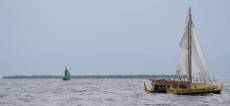
Hokule'a and Maisu off Pollap. Photo by Mike Taylor
Pollap (Pulap) is a low island whose only tall feature is coconut palms. Pollap is one of a "net" or "string" of small islands which sits astride the direct route from Chuuk to Satawal. They are a key landmark enroute; but, at the same time, pose a real hazard to navigation. In an amazing display of navigational skill and expertise, Hokule'a spotted Pollap at a distance of about nine nautical miles during a heavy squall on a day when the visibility was really quite poor.
March 12-15 Sailing to Satawal
Hokule'a, Alingano Maisu and escort boat Kama Hele left Chuuk on a Monday afternoon, along with an additional contingency of about 10 people from Hawai'i, on a chartered boat. Hokule'a was the lead canoe on this leg to Satawal. Nainoa Thompson was the Captain and Navigator, but also on board were navigators Chad Baybayan and Bruce Blankenfeld, as well as apprentice navigator Ka'iulani Murphy. Also on board were three other crewmembers from the original 1976 voyage: Billy Richards, John Kruse and Snake Ah Hee. A large crew of 22 sailed to see and honor their teacher master navigator Mau Piailug. After a day of squalls and making great speed, crewmembers Pomai Bertelmann and Max Yarawamai spotted Satawal on the horizon, directly ahead of Hokule'a.
Aloha, Kathy

Satawal Ahead. Photo by Na'alehu Anthony

Maisu off Satawal

Landing on Satawal. Photo by Gary Kubota, Honolulu Star-Bulletin
March 15-20 On Satawal
The following morning crews of all vessels went ashore to a beautiful welcome from the people of this tiny island one mile long and half-a-mile wide - a population of about 500. The crew was greeted by the 3 chiefs of the island and Mau. After two days of preparation and visiting, the men who would go through pwo (pronounced poh) were sequestered in the traditional men's house. On Sunday, before noon, the pwo ceremony began, conducted by Mau. Pwo is a graduation of sorts. You are chosen for pwo, you do not ask for pwo. It is given after you have proven you can sail and navigate. Mau is the last on the island of Satawal who knows how to conduct the sacred pwo ceremony, and it is said it was the first pwo on Satawal in decades and the first pwo for foreigners ever. The pwo was given to Shorty Bertelmann, Chadd Paishon, Chad Baybayan, Bruce Blankenfeld and Nainoa Thompson, all of Hawai'i and all students of Mau.
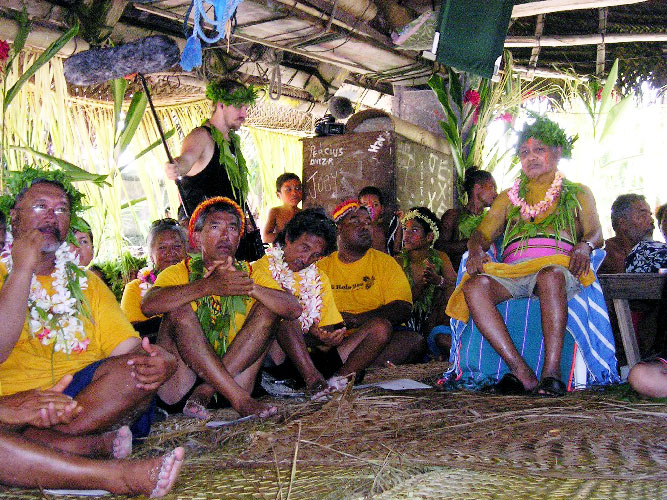
Mau with Navigators on Satawal (2007). Photo by Gary Kubota, Honolulu Star-Bulletin
It was also given to 11 men of Satawal, including Mau's son Sesario who sailed on the Maisu from Hawai'i and who will take responsibility for the Maisu in Micronesia. The elders say that those who go through pwo, which includes a series of chanting and rituals, must carry love, respect and light. They focus with all their mind and heart and allow that and only that to guide them to their destination.
Following pwo, the chiefs were presented with gifts, Mau was presented with gifts from across Polynesia and finally he was gifted with the Alingano Maisu. The following day Mau and his family hosted the crewmembers for a dinner.
Aloha, Kathy
For an Account of Events on Satawal and the Pwo Ceremony, with more Photos, see Sam Low's "Ku Holo Mau."
Thoughts on Satawal / Kimo Hugho
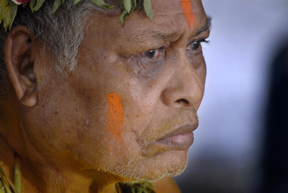
Mau. Photo by Sam Low
At your beginning, Papa Mau, Mariah and I observed your hulls being released from its embryonic-like molds ever so delicately by Jay and Mr. Ong
At your blessing, the winds were strong and you appeared as if you wanted to run, like the winds providing the CPR-like shock to get you up and going. Your mooring lines were taut as you began breathing your winds. Shorty, Boogie, Buffalo and myself knew at that moment that you were downloading and would never ever flat line.
Coming into the waters of Chuuk, the sight of Hokule'a and you very close in her wake provided such a powerful statement, the seasoned mother ship and her child, the space ships of our ancestors.
Once under sail, Chuuk was just a memory and the next many hours were spent getting adjusted to the new life style, sea legs with body and mind ready to respond, yet in an efficient and safe manner to get you in line for Satawal.
Your wide and uncluttered deck afforded safe movement for forward sail handling and provided for ease of access to the over the hulls crew cubby holes. I foresee that you would be ideal as a first responder vessel in any emergency situation.
Paniau, your steering sweep is well balanced and in many instances would not require any over powering efforts although there can be moments where a critical correction would be necessary.
Often, as Hokule'a ran forward of us and became a very distant mark, almost over the horizon, Shorty and Chad would call for more sail and you would instantly go into overdrive at a speed beyond description yet very much in control. I believe that your full speed potential has not yet been realized but, your safety and the safety of your care-givers is foremost.
I was very impressed with your wahine crew, five of the best that I have seen and privileged to have sailed with. They are all humble, focused, caring, organized, clean and intelligent and are exactly what you deserve, extraordinary care-givers. Once Poomai came on board prior to Yap, I knew that with a few additions of able wahine, that this crew could do a distant landfall voyage, turn around and return in record time and safe.
Papa Mau was happy to see you anchored off shore from the men's canoe house on Satawal as it showed in his eyes as he celebrated into the night and telling us that he would be sailing with us to Yap.
Leaving Papa Mau was very sad. As he lay on his bed in his hale, we gathered around him, blurred by tears that were warm and which fell to his cement floor, perhaps our DNA forever with him. Personal messages were spoken to Papa but I could not ever say goodbye. Instead, "Papa, the sun does not know goodbye, only hello, we love you!" as I touched his big toe and headed for you.
As Satawal began to decrease in size, we headed into the sun and you came to life in your winds and gave us the happiest ride of a life time. Thank you for the moments to re-sensitize away from terra firma, where we tend to gravitate to and become entrenched with the land animal stuff.
You are in good hands with Ses, Eddie and the boys and please scold them if they spit that red thing anywhere forward of the aft manu.
You are the precious child who we will be visiting very soon.
Kimo Hugho '76
March 20-26 Woleai, Ulithi and Yap
On Tuesday,March 20, the vessels left Satawal for Woleai with the Maisu in the lead. Woleai provided crewmembers with a beautiful welcome and after a nights stay, sent the crews off with song and dance.
From Woleai, the vessels sailed for Ulithi with Hokule'a in the lead and Nainoa Thompson handing over the navigation to Ka'iulani Murphy who successfully brought the vessels to Mogmog, Ulithi. Unlike Satawal and Woleai, Ulithi has electricity.

Ulithi Atoll. From Wikipedia
The people of Mogmog treated crew to more song and dance and the first cold sodas and ice cream in a while. After a night on Mogmog the vessels sailed across Ulithi Atoll in a couple of hours to the island of Fatharai, the home island of crewmembers Max Yarawamai and daughter Ana Yarawamai of Waimea on the island of Hawai'i.
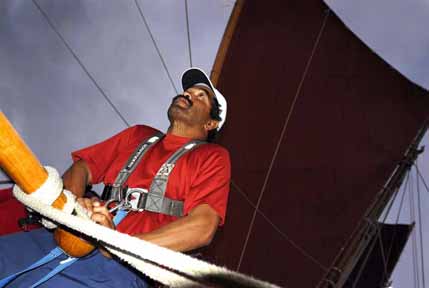
Max. Photo by Sam Low
Fatharai is home to 70 people, as many have been leaving for Mogmog since it got electricity. The people, including Max's family, are beautiful. Max has been on many voyages and often serves as the eyes of the canoe, having been raised to spot an island from great distances. Max left Fatharai at age 13 and went to Hawai'i. He has a successful business and is now giving back, having co-founded a non-profit called Oceania Community Health, which looks to serve and empower the peoples of Micronesia by addressing, with the community, its health needs. He and his brother Dr. Thane Hancock, who is in Yap, showed the crew the site of a planned dispensary in Fatharai.
The vessels left Fatharai Thursday late afternoon and, with Maisu leading the way, and beautiful weather, they arrived in Yap yesterday morning (Monday morning Yap time, Sunday afternoon Hawai'i time). After an evening of rest, the crews are cleaning the canoes and escort boat, will be reprovisioning and after some crew changes, the canoes and Kama Hele should be leaving on Friday Yap time (Thursday afternoon Hawai'i time). They will be sailing to Palau.
Most of the crew of the Maisu will be flying Continental Airlines from Yap over the next two days, having completed the gifting of the canoe to Mau and Micronesia. A largely Micronesian crew will be sailing her to Palau and back to Yap, its homeport. Several crew of Hokule'a will be flying Continental Airlines home as well, with another group of crewmembers flying in tomorrow. Among them: 3 from The Nature Conservancy as Palau serves as a great lesson and example in environmental conservation, plus two high school students, Waimea McKeague of Nanakuli High School and Aaron Akina of Kamehameha Schools. A doctor from the Aloha Medical Mission, conducting clinics in Ulithi right now, will board Hokule'a as the on-board doctor to Palau. His name is Dr. Vernon Ansdell. Also joining the crew will be the president of Palau. The trip to Palau should take 3 days.
Aloha, Kathy
March 21-24 Departing Satawal for Woleai and Ulithi
In Satawal we said goodbye to our brothers Jason and Innocenti, in Woleai we said farewell to our dear friend Eddy. We said aloha to uncle Snake, uncle John, Uncle Shorty and Babs and uncle Bruce, and to all our family members and friends who couldn't continue on with us but had to return to Chuuk on the Chuuk Queen. Thanks to them and all our families at home for all the time and love that we have put into the creation of Maisu and for the the planning and preparations that we have all taken part in in order for the three to carry out this epic voyage.
Chief Gabriel Tokomai of Satawal sailed on Maisu from Satawal to Woleai - Albert, grandson of Piailug is a new comer on board. He has a gentle spirit and works really hard to help. I cannot tell you how blessed we are to have had the time to get to know the Micronauts. We now know Atarino and Largo and they too are so good to us. Having them on the canoe is an added level of comfort in knowing that the promise of Maisu will live on.
We departed Ulithi, Mogmog island to be exact around 10am this morning. The home of Max and Ana...what a pleasure it was to be able spend the evening here...so peaceful, full of aloha...feels just like home. We feasted on coconut crab, lobster and fish - we couldn't have asked for anything more. We rested peacefully under the moon and stars that have graciously guided us to and through Micronesia. What a beautiful place to collect our thoughts and to spend time with each other before making the move back to a faster paced world than what we've become accustomed to. Hokule'a in all her wisdom graces us with her presence - Kamahele..the child of the sea she is, has been so good to us. Watching our back, always on watch just for us. This is going to be a very hard separation...this is going to be like adopting one of your own out to another family...this isn't going to be easy. We have all experienced the same voyage from different lenses. We each have our stories in our journals to fall back on...we each sail for different reasons....we each will go home and share in bits and pieces for a very long time.
This run, "Venus to the Moon a run for CAPT." is dedicated to all those who were not physically able to make the sail with us at this time but have helped us to fulfill the promise and carry out our dreams, This one is dedicated to our families at home and to those who have already transformed to that place beyond the veil, We miss you all very much....we will see you in a few days or we will see you in our dreams... This run is for the great big "IWA" in the sky who has been with us constantly, reminding us that he is never far away, This run is for the "Pi'olualani", Makali'i - at home....we look forward to the time when you will grace the sea with your presence, This run is our promise to each other, to 'Ohana Wa'a, the promise that we will always, always support and take care of one another, This run is for Hokule'a - and all the other canoes that have taught us all that we know.... This is also "our run" for Papa Mau and his family. You will always be in our hearts....like the Honu, you are with us always...the heart never stops beating....we will never forget!
In the morning we will greet Yap....we will join up with old and new faces - we will take care of the canoes like we do our children, with a nurturing spirit...with love...with aloha.... So, from all of us who are blessed to be on the sea at this time...to all of you who we will embrace in a few days...
Me Kealoha Nui,
The crews of Hokule'a, Alingano Maisu and Kamahele....
Eo 'Ohana Wa'a
March 25 Departure from Ulithi; Earlier stop at Woleai and Ulithi
As we sail toward the setting sun, the beautiful islands of Ulithi seem to be sinking below the horizon behind us. Our two day visit was a special one because we’ve sailed to the home island of our fellow crewmember Max Yarawamai. Max, the oldest of 9 children, came to Hawai’i when he was 13 years old where he lived with the Hancock family in Waimea, went to school and later began a new family with his beautiful wife Cindy and their two daughters Ana and Mikela. Ana is sailing with us as well, and it has been wonderful sharing this experience with father and daughter.
From Woleai we sailed about 280 miles to Ulithi, Max saw the glow of the islands before dawn and we came into the channel just after sunrise. Our first visit was at Mogmog, the chief’s island. We were greeted on shore with beautiful singing and lei, and then gathered in the men’s house where Chief Hilary welcomed us to their islands. The people of Mogmog prepared meals for us and performed their traditional dances. We got to meet some of Max’s family who live there as well as his brother from Hawai’i, Dr. Thane Hancock, who came over for the day from Yap to see Max and Ana. Dr. Thane has been living in Yap for the last year and a half, working at the hospital in public health. (He intended to spend just the day with us and fly back to Yap, but we wouldn’t let him go and he is sailing to Yap with us too.) There is such a good feeling about the island and its people, and it was sad to leave this morning.
We sailed across the lagoon to Max’s home island of Fatherai, where his parents and family still live. His father, the chief of the island, welcomed us in the men’s house, and the women and girls did their traditional dance while we ate another great meal prepared for us. Max showed us the foundation for a health center he will soon build on the island. His dream of bettering health care throughout the Pacific led to Oceania Community Health, a non-profit organization that will begin with this health center on Fatherai. Max hopes this first one will be a model and just the beginning of more to come on these small islands that don’t have easy access to health care.
It was beautiful to see Max and Ana reunite with their family on both islands, after sailing hundreds of miles on a voyaging canoe to return home. As much as we would have loved to stay longer, we had to leave the lagoon before sunset. Many of us look forward to coming back with Max and his family to help make his dream a reality.
Much aloha,
Ka’iulani
March 26 Arrival in Yap
Before dawn this morning we saw the glow of the lights in Yap. Sesario did a great job of navigating Maisu here, and we followed close behind. After sunrise we are sitting outside the channel hooking up tow with Kamahele to enter Colonia, Yap.
It was a quick sail and we have lots of work to look forward to here in Yap.
We will miss much of the Maisu crew who are flying home from here in a few days. Hokule'a will be reprovisioning in preparation for our sail to Palau, back to Yap and on to Okinawa.
Much aloha,
Ka’iulani
March 26-29 activities on Yap, provisioning for Palau
Five fresh new additions to the crew (Emily Fielding, Eric Co, Waimea McKeague, Aaron Akina, and Pauline Sato) arrived at Yap to meet the seasoned crew and help provision Hokule’a for its trip to Palau and back to Yap, and all the way to Okinawa. Yap is where the Matson half-container full of non-perishable food and supplies were sent from Hawai’i. When we arrived on the morning of the 28th, Timmy Gilliom was already hard at work. The canoe was to be cleaned top to bottom – extraneous items left behind from past crew members removed, sails washed and dried, electronic equipment maintained, foul weather gear washed and assigned, and perhaps most importantly, food carefully packed and stored for each day. Ka’iulani is the master of provisioning while on the voyage, but no one canoe forget or overlook the hard work of Lita Blankenfeld and her crew of volunteers back home in Hawai’i to purchase and get the food to us. Lita planned out more than 30 days’ worth of meals, breakfast, lunch, and dinner to satisfy nutritional needs as well as tastebuds. She also provided a well thought-out 3-ring binder outlining the menus for each day (with recipes, if needed) and individual ingredients per meal. What a feat of organization!
Cleaning and reprovisioning took nearly four full days. Our instructions were to do everything needed here in Yap so that once the canoe returned from the leg to Palau, very little more would need to be done outside of purchasing some fresh produce. Therefore, our sight-seeing opportunities at Yap were limited to the walk from the hotel to the harbor, which actually was quite scenic. Some of us were fortunate to have been able to attend a traditional farewell ceremony at a village about 20 minutes away. We passed by a stone money “bank” (what looked like a beautiful garden decorated with very large, round and flattened stone pieces with a hole in the center). The ceremony was held at a traditional men’s house made entirely of natural materials. We were treated like royalty with dignitaries giving speeches and a lot of delicious local food including fish, chicken, taro, and breadfruit. We were also entertained by a traditional women’s dancing group who mesmerized us with their chants and motions.
The evening prior, a huge feast for the crews of Hokulea, Alingano Maisu, and Kamahele was given by the local community, right at the dock at a beautiful gathering area. Chadd Paishon spoke on behalf of the crews and shared very eloquent words about the meaning of this voyage and the gift of the Alingano Maisu to the people of Yap and Micronesia. It was a poignant moment. And even from a newcomer’s perspective, observing the Hawai’i-based crew of the Alingano Maisu, including Chadd Paishon and Pomai Bertelmann, say farewell and offer their hopes and dreams to the canoe in silence was especially touching. What that moment must have felt like I can only imagine.
But back to the provisioning, one of my most distinct and humorous memories is packing the rolls of toilet paper, two rolls per sealed bag, then double-bagged in large garbage bags. We had over a 100 rolls laid out on the tarp, along with other supplies. What the local people who came by to the harbor to see us must’ve thought! Such necessities of our modern lives.
When we departed from the harbor, we felt ready to go. More than 70 people from the community gathered along the dock to bid us farewell. The Kamahele took us out the harbor until we could safely open our sails. The Alingano Maisu, manned now by an all-Micronesian crew, immediately followed. Uncle Maka’s blowing of the conch and the response by car horns until we could no longer hear them gave me chicken skin. The excitement for our new crew is just beginning.
(by Pauline Sato)
The following is an excerpt from a speech by Sabino Sauchomal, March 27, Yap Island.
Greetings from Yap State Legislature...
Tonight I join the governor and other state officials in once again extending to all of you a very hearty and warm welcome to our humble state center. You have been here two days and one night, but you have already passed through some of our islands starting in Satawal, Woleai, Ulithi, and now Yap, so I am sure you have already experienced first hand many of our short comings and other inconveniences. I now render our apology. Some of these short comings may be my own fault and some may not be my own fault but I feel very generous tonight, I want to apologize for them as well.
Seriously, we are very happy to finally have all of you here with us. It was for a very long while that all we could tell about you, was the postings on the internet by Kamahele of your long and winding journey towards us via the Marshall Islands. That leg of the trip posed some challenges to the voyage as bad weather set in and mishap on one of the boats occurred, according to the internet postings. As ocean people ourselves, our hearts went out to you for we to have experienced first hand misfortunes and mishaps. Our only comfort was in knowing that you had been trained by the best.
Your arrival here marks the end of yet another leg of this epic journey. In a few more days, you will have embarked on yet another leg. But tonight, we celebrate not only the end of the Yap leg of the journey but the beginning of a journey of a different kind for our two peoples. The friendship we have developed through these voyaging endeavors and the free exchange of knowledge, ideas, and the proper stewardship of ocean resources as well as other natural and practical arts will further strengthen our communities of voyagers.
I believe we are not all different from one another. But even if we are, we should focus more on our cultural similarities than our differences. Polynesians and Micronesians are both island people. Our only difference is that some have many islands while other have small islands as the names alluded to. By an accident of geography, we are separated. But through the power, knowledge, and skills found in the art of traditional navigation, we are united. The seas are our highways. Your epic voyage through Micronesia is a living testament to that truth. They connect us to the hearts of other communities around us and bring us together. So you see, ladies and gentlemen, we are not at all very different. And we are not very far apart at all. We just have to work a little harder to find ourselves in this huge and mighty blue playing field of ours. We must rise above the cultural boundary and reach out and touch other cultures.
March 30 Departing for Palau
The voyaging canoes Hokule'a, Alingano Maisu and escort boat Kama Hele left the dock at Colonia, Yap at about 2:00 this afternoon Yap time, which is Friday, March 30.
Hokule'a is taking the lead on this leg, with Nainoa Thompson as captain and navigator.
The focus in Palau is our environment and caring for one's island home. Thompson says the world's environment is in trouble and although "we can't change the world, we have a place called home. When our oceans are at risk, we're at risk. The debate should be about what we value. I think Palau is a place where we can learn from and get ideas from. We want to tell their story. Their story is about people making the right choices. It's about our relationship to our environment."
The Alingano Maisu left Yap with an all-Micronesian crew for the first time, as the Hawai'i contingency who built, sailed and gifted the canoe to master Navigator Mau Piailug, completed the gifting in Mau's home island of Satawal. Mau's son Sesario is now in charge of the canoe. He is the captain and navigator on the Maisu for the sail to Palau and back to Yap.
His family hosted a beautiful dinner near the vessels on Wednesday night, the night before the Hawai'i group, from Na Kalai Wa'a Moku o Hawai'i, had to fly home. As the group left the gathering they stood by the Alingano Maisu, sang, and said a tearful good-bye as they acknowledged the completion of the circle and their labor-of-love for the last five years. It was very hard to say good-bye but the hopes and dreams are that the Maisu will help inspire the young and perpetuate the voyaging and navigational tradition in Micronesia, which had helped to rescue the same in Hawai'i.
This voyage to Palau should take two days, arriving Sunday, Palau time. Depending on weather, the vessels will leave Palau around April 5th.
We thank Continental Airlines for their continued support and flexibility as our travel plans are at the whim of mother nature. We also thank Matson Navigation and Mariana Express Lines Limited for their generous support in transporting provisions and parts for the canoes and escort boat to Micronesia and back home.
Aloha, Kathy
Crew to Palau
Nainoa Thompson
Dr. Vernon Andsdell
Timothy Gilliom
Attwood Makanani
Kaiulani Murphy
Naalehu Anthony
Keoni Kuoha
Pauline Sato
Dennis Eric Co
Emily Fielding
Pomai Bertelmann
Patti Ann Solomon
Waimea McKeague (student at Nanakuli HS)
Aaron Akina (student at KS)
Tommy Remengesau, Jr., President of Palau
Two who joined Hokulea’s new crew were very special, indeed. Tommy Remengesau, Jr., the President of Palau, and Jennifer Yano, coordinator-extraordinaire, became part of the team.

As Nainoa said, we’ve never had a president of anything aboard Hokule’a so we didn’t quite know what to do . . . should we speak to him only when spoken to, should we make sure he doesn’t lift a finger? Our concerns were soon alleviated when the President was the first to pull in the fishing line, bare-handed, when we caught our first fish, a mahimahi. He jumped into the rear of the canoe and pulled in the fish carefully, then cleaned and filleted the fish as skillfully as any fine chef in Hawai’i. We knew then that the President was a down-to-earth man who didn’t hesitate to get his hands dirty.
Mr. President was also eager to be a fully participatory member of his five-person “four-hour watch” That meant getting up at 2 am and helping steer using the stars, sheet in the sails, learn about the stars from the navigators and keep each other company. Being a avid fisherman, he had many stories to tell about his adventures out at sea.
We had the unique opportunity to interview the President, on camera, aboard Hokule’a. He talked about his concern for the environment at a time when Palau is at a crossroads with modern development knocking at her door. His commitment to ensure an economically healthy future while protecting the environment and culture of Palau was evident. In fact, he is largely behind the “Micronesia Challenge,” a shared commitment among nations in Micronesia to protect 30% of its nearshore marine environment and 20% of its forested watersheds by the year 2020. Being that Hawai’i is nowhere close to that either on land or in sea, this is something to admire greatly about Palau and her Micronesian country neighbors, and clearly something to which we can aspire.
(Text and photo by Pauline Sato)
April 1 Arrival in Palau
Nearly one-thousand people greeted the arrival of the voyaging canoes Hokule'a and Alingano Maisu, and escort boat Kama Hele, at Malakal Harbor, Koror, Palau at about 3:00 Sunday afternoon Palau time (Saturday night Hawai'i time). Hokule'a captain and navigator Nainoa Thompson says they spotted the glow of the lights of Palau at about 3:30am Sunday. They had left Yap Friday afternoon.
The president of Palau was on board Hokule'a for the journey from Yap. A Palauan Coast Guard ship met up with the three vessels Saturday night and stayed with them all the way to the channel entrance. At the entrance, traditional Palauan war canoes met them with chanting and the blowing of the conch shell. They then escorted the vessels to dock where they were greated with traditional song and dance.
Palauan friends of the Polynesian Voyaging Society hosted a dinner for the crew last night. Today, some crewmembers are visiting high schools, talking with students, then providing tours of the canoes, while other crewmembers are working on the canoes, changing rigs etc...Tonight, the president of Palau will host a dinner for all crewmembers and Thompson will give a voyaging presentation. Tomorrow, crewmembers will be visiting concervation programs and sites.
The vessels will depart Palau later this week as they wait for favorable weather to sail back to Yap.
Aloha, Kathy
Conservation Day in the Rock Islands
Palau – Today the focus was on marine conservation in the Rock Islands of Palau.
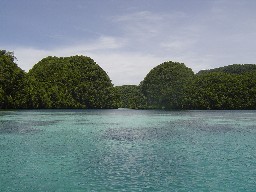
Days don’t get much better than this. Na‘alehu put on his videographer’s hat and took off at the break of dawn with “key grip” Eric Co and staff of the Palau Conservation Society to shoot some B-roll (raw footage) of the Rock Islands in the gentle light daybreak. The rest of the crews of both Hokule‘a and Alingano Maisu assembled on the dock near our apartment by 8:30 am to begin a day planned for many weeks, if not months, by our hosts at the Palau Conservation Society, the Koror State Department of Conservation, and Sam’s Tours. Tiare Holm, Executive Director of the Palau Conservation Society and Scotty Keifer, the Society’s education and outreach officer, and Adalbert Eledui, Director of Conservation and Enforcement of the Koror State Government led the field trip in the Ngemelis complex area of the Rock Islands that included stops at “Big Drop Off” and the famous and magical Jellyfish Lake.
We snorkeled along an 800’ wall rich with hundreds of species of soft and hard corals, invertebrates, and schools of fish large and small. We saw a couple of endangered Hawksbill turtles as well as black-tip reef sharks. At Jellyfish lake, there may have been 17 million stingless jellyfish, give or take a few, floating all around us. For most of us, this was our first time in this type of ecosystem, which left us without adequate words to express an out of world experience.
To minimize our environmental impact to the sites at any one time, we split into two groups. And to maximize our appreciation for what the Koror State government is doing to promote conservation and sustainable use of the resources, we gladly paid the $15 permit individually to allow for visitor use of the Rock Islands (valid for two weeks). The funds generated from this simple permit system totals to more than $1.5 million annually, which is used to pay for the 16 conservation officers who patrol the area 24 hours a day, 7 days a week; road and harbor improvements, and litter clean up. In the Rock Islands, tourists are permitted in only seven areas, and commercial fishing is not permitted. Community-based fishing for non-commercial purposes is allowed but certain techniques such as spearing using any kind of underwater breathing apparatus (e.g. SCUBA) are prohibited.
Restrictions are much more stringent than we are used to in Hawai‘i, yet there is not a feeling of loss or unfairness. The Palau Conservation Society and Koror State Government worked closely with local communities in the state for more than two years to identify values that community members want to perpetuate for future generations. They want a healthy marine environment that produces food for the table and a stable economy. Funds raised from the permit system pay for practically everything, which benefits business and community as well as the environment. As Adalbert Eledui, lead architect of the Rock Islands management plan told us, “a large Napoleon wrasse may be worth $100 in the market, but is worth a hundred times that left in the water.”
There is so much more to say about our “conservation” day . . . but this will have to wait for another moment when we have more time to reflect.
(Text and photo by Pauline Sato)
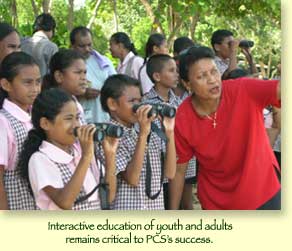
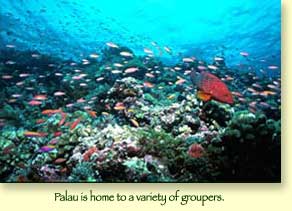
Photos from the Palau Conservation Society website.
April 5 departing Palau
Palau - The canoes are ready on the Neco Marine dock where they have been at home since arriving on April 1. As our gracious hosts for the past week, the organizing committee once again put together a memorable ceremony for our farewell, providing breakfast for all who came down to see the canoes back to Yap. We were inspired by remarks by High Chief Reklai Ngirmang, Koror State Governor Yoshitaka Adachi, crew member Jennifer Yano, Alingano Maisu Captain Sesario Sewralur (Mau Piailug’s son), and Hokule‘a Captain Na‘alehu Anthony. The captains promised to continue the relationship between Hawai‘i and Micronesia and perpetuate their rich navigation and voyaging traditions through the school of navigation. Mechesil Belau women presented a traditional food basket for the voyage to Yap, filled with cooked taro, sweet tapioca rolls, smoked fish, cans of tuna and corned beef.
Last evening, the crew gave a tour of the Hokule‘a to Palau Canoe Association members and Palau Conservation Society Staff that went on into the night with exchange of gifts, and tears and farewells.
The canoes were escorted out of Malakal Harbor by the traditional Palau war canoes from four different states.
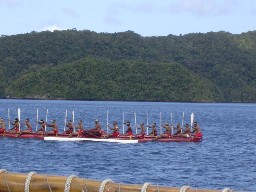
Palau war canoes. Photo by Pauline Sato
Painted with the colors of their village, each canoe sat from 12-16 men in traditional malo, sitting two abreast on cross pieces level with the gunnels, with one foot outside the canoe in a looped rope near the water. The paddle blades were long and pointed at the end. The canoes had an outrigger with a platform, where a team member led the crew in paddling and chant. A special chant for Hokule‘a still rings clear to all of us who were honored by this very special practice of custom and tradition. Uncle Maka responded with the blowing of the pu as we headed for open ocean.
(by Emily Fielding)
April 5 Palau crew
Departure from Koror, Palau, 04/05, 3 p.m.
The next generation of leadership is at the helm of Hokule'a as the voyaging canoe, along with Alingano Maisu and the escort boat Kama Hele left Palau this afternoon - Friday morning Palau time. They are on their way back to Yap, where they are expected to arrive in two to three days.
Na'alehu Anthony, 31 years old, is captain of Hokule'a for this leg. Ka'iulani Murphy, 28 years old, is Hokule'a's navigator. PVS has confidence in this younger generation of leadership and continues to provide opportunities for them to grow and to ultimately become the caretakers and teachers of this Hawaiian tradition.
Sesario Sewralur, son of master navigator Mau Piailug, is captain and navigator of the Alingano Maisu. The Maisu will remain in Yap, under his care, as the Maisu was gifted to Mau and the people of Micronesia by the voyaging organization Na Kalai Wa'a Moku o Hawai'i.
In Yap, five Hokule'a crewmembers will fly home to Hawai'i and four crewmembers will fly in, including captain and navigator Nainoa Thompson, Pomai Bertelmann and Chadd Paishon of Na Kalai Wa'a Moku o Hawai'i, and Timi Gilliom of Maui. Hokule'a's crew of eleven will then wait for favorable weather to make the estimated 12 to 14 day journey to Okinawa.
[Note: Favorable weather means solid trade winds, "with no indications of circulating clouds that could create typhoons."]
Aloha, Kathy
April 7 arrival back in Yap
Yap - The crews of Hokule‘a and Alingano Maisu arrived in Yap, Easter Sunday, to a quiet Colonia Harbor. A few old friends from Yap and Satawal were there to greet the canoes, as were crew members re-joining the voyage, Chadd Paishon, Pomai Bertelmann, Timmy Gilliom, and Nainoa Thompson – with a gallon of ice cream and cans of root beer on ice for a well deserved dockside root beer float. Immigration came down to check the passports and customs to quarantine any fresh fruits and vegetables. The crew scrubbed the decks, canvases, and each of the 10 sleeping holds, and off loaded their personal gear packed in dry bags and coolers, and scrubbed and pumped out each area in preparation for the new crew coming on for the sail to Okinawa. Sunset over the glassy green waters of the harbor, flanked on the two points by traditional men’s meeting houses, and now defunct corrugated fish packing warehouses. The crew enjoyed dinner together, sharing stories of the days past and adventures yet to come – celebrating the arrival of the Hokule‘a to Yap under the leadership of Captain Na‘alehu Anthony and Ka‘iulani Murphy.
(by Emily Fielding)
April 10 standing by
Crewmembers are on standby for a possible departure at about 3:30 pm Yap time (7:30pm Hawaii time) today; however, captain Nainoa Thompson says there is one-hundred percent cloud cover and bouts of showers. He says this is not dangerous weather but it could improve; therefore, he may delay departure until it does clear up. I will update you again tonight.
Thank you. Aloha, Kathy
Aloha,
Hokule'a did not leave Yap on 4/10 (HST) because of bad weather: one-hundred percent cloud cover and heavy rain. They will check the weather tomorrow and make a decision then. Thank you, aloha, Kathy.
Track of Canoes from Majuro to Yap (Oceanography Department, UH Manoa)

Hokule'a Crew List for Yap to Okinawa:
Nainoa Thompson
Dr. Pete Roney
Timothy Gilliom
Attwood Makanani
Kaiulani Murphy
Pomai Bertelmann
Chadd Paishon
Kanako Uchino
Kaina Holomalia
Maile Neff
Takuji Araki
Keoni Kuoha (not yet confirmed)
Kamahele Crew List:
Joining the crew in Yap is Sam Monaghan; joining the crew in Palau is Boy Luethje. Leaving from Palau are Mike Cunningham, Bill Beadle, and James Hadde. To Okinawa: Mike Taylor, Lee Taylor, Erik Norris, Sam Monaghan, and Boy Luethje. Captain Mike Taylor will add one or two more crew.
